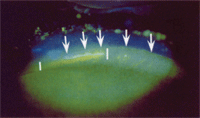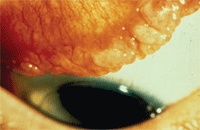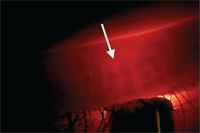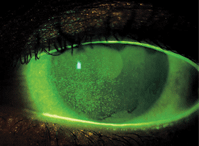The introduction of the silicone hydrogel (SiHy) lens modality in 1999 opened a whole new world of options for optometrists to recommend and prescribe to patients. Initially intended for extended-wear, SiHy lenses started being used for daily wear around 2003.1
Since then, they have secured an increasingly important role in the market and in practice—now accounting for nearly two-thirds of all lens fits and refits.2 Several studies have concluded that patients achieve greater comfort with SiHy lenses when compared to their hydrogel counterparts. SiHy lenses have shown similar comfort upon insertion, but sustained comfortable wear throughout the day.3-6
Despite all the innovations in SiHy lenses, contact lens comfort remains a major issue for patients and optometrists. In a survey of nearly 900 patients, 52.7% of contact lens wearers, 17.4% of spectacle wearers and 7.3% of emmetropes reported dry eye.7 This poses a significant challenge for patients who seek a high level of comfort with continuous wear of their contact lenses.
Because a significant portion of our contact lens patient base utilizes SiHy lenses, it’s vital to understand the inherent hydrophobic properties and to alleviate the issues that patients may encounter because of them.
First, give the lenses a head start by having a uniform, healthy tear film. Maximize comfort by utilizing the appropriate lens, lens-solution combination, care schedule and patient behavior modifications. Remember, it can take some time and experimentation with different options to find a comfortable lens that fits the patient’s lifestyle and clinical needs.
When it comes to finding the right fit with a silicone hydrogel lens, let’s look at the four most important factors you should consider: the ocular surface, the lens and materials, the solution and its biocompatibility, and patient compliance.
The Ocular Surface
It’s not a surprise that patients with a compromised ocular surface find contact lenses difficult to wear. But, by identifying specific markers, we can help our patients achieve more successful, more comfortable lens wear. Throughout the ocular examination, it’s crucial to keep all aspects of the ocular surface in mind and to take note of how one component can have a negative effect on the next.
Blepharitis has several factors that need to be evaluated. First, you’ll want to look for any signs of anterior blepharitis—the classic red eyelid, often accompanied by crust and flakes. This condition can have a dramatic effect on the patient’s overall ocular comfort, and contact lens wearers may not be able to differentiate this type of discomfort from that which they may experience with their typical contact lens wear. Often, you can pinpoint anterior blepharitis because patients experience a generalized irritation and an itchy sensation.

Lid wiper epitheliopathy may increase the sensitivity of the cornea and traumatize the corneal epithelium.
Photo: Donald Korb, O.D.
Perhaps the more significant component of blepharitis that contact lens wearers encounter is posterior blepharitis or meibomian gland dysfunction (MGD). In March 2011, the International Meibomian Gland Dysfunction Workshop published a report that was created with the collaboration of more than 50 experts over two years. It defines MGD as “a chronic, diffuse abnormality of the meibomian glands, commonly characterized by terminal duct obstruction and/or qualitative/quantitative changes in the glandular secretion.”8
This may result in alteration of the tear film, symptoms of eye irritation, clinically apparent inflammation and ocular surface disease. Although treatment of MGD is still debated, appropriate interventions should be determined based on severity and symptoms. Common treatment options include the use of warm compresses, omega-3 fatty acids, topical azithromycin, oral tetracyclines, gland expression or probing, topical cyclosporine and artificial tears.
In addition to evaluating the lids for blepharitis, you should carefully perform a lid eversion to look for signs of giant papillary conjunctivitis (GPC) or lid wiper epitheliopathy (LWE). Evidence of GPC on the upper eyelid often indicates hypersensitivity or mechanical damage from contact lens wear.
This lid wiper region is the area of the lid that slides over the ocular surface, cleaning and restoring the protective tear layer. One study showed that 76% of contact lens wearers who were symptomatic for dry eye had staining in this area, indicating LWE.9,10 This condition may traumatize the corneal epithelium and increase the sensitivity of the cornea, so patients with LWE need lenses or solutions that decrease mechanical stress.10 It can help to switch the patient to a contact lens that has a smoother surface, recommend that they rub the lenses during cleaning, and suggest a new solution for a more wettable lens surface (with a lower coefficient of friction) that decreases protein and lipid build up.

Evidence of giant papillary conjunctivitis on the upper lid frequently indicates hypersensitivity or mechanical damage from contact lens wear.
Beyond the lids, it’s important to assess the quality and quantity of the tear film. Through the use of a phenol red threat test or simple evaluation of the tear meniscus, a skilled clinician can evaluate a patient’s volume of tears. But perhaps even more important than the volume is the quality of the tears. You can determine the tear quality by evaluating tear film break-up time and tear osmolarity, as well as examining the corneal surface. Patients with decreased quantity and quality may benefit from artificial tears, punctual plugs, Lacrisert (Aton Pharma) inserts or topical cyclosporine.
Finally, inspect the cornea for staining. Some patients may have corneal staining due to contact lens wear or improper contact lens solution use, while others may have developed staining due to dry eye disease. You can better understand the etiology by looking at the location, depth and amount of staining present. Many optometrists use artificial tears, topical cyclosporine or anti-inflammatory drops to decrease staining.
Lens Material
In the late 1800s, the first successful contact lenses were fitted. Made from glass, they caused considerable eye irritation and were not wearable for an extended period. It wasn’t until the 1930s that contact lenses became more convenient when William Feinbloom, O.D., Ph.D., introduced the first rigid corneal contact lens with polymethyl methacrylate (PMMA), a hard plastic alternative to glass. However, one of the most significant adverse effects to these “hard” lenses was the lack of oxygen permeability, because they did not allow any oxygen to be transmitted to the cornea. In the 1970s, the first rigid gas-permeable (RGP) lenses became available, offering improved oxygen permeability.
• Johnson & Johnson incorporates a
wetting agent into the matrix of their Acuvue Advance with Hydraclear
(galyfilcon A dk/t 85.0) and Acuvue Oasys with Hydraclear Plus
(senofilcon A dk/t 147.1).
* The toric and multifocal designs from
each of these manufacturers incorporate the same wetting system as their
sphere counterparts.
Since then, the industry has continued to experiment with polymer composition in order to enhance their quality and allow more oxygen permeability. After decades of research and hypothesis, the first readily available silicone hydrogel lenses hit the market in 1999. With the introduction of silicone as the major carrier for oxygen, the incidence of corneal edema and chronic oxygen deprivation decreased considerably.
Maintaining Moisture
Several contact lens manufacturers have
set their brands apart from one another by using unique formulas to
offer better wettability.
• Bausch + Lomb’s PureVision (balafilcon A dk/t 110.0) and
PureVision 2 HD (balafilcon A dk/t 130.0) line of lenses utilizes a
plasma surface treatment.
• CIBA Vision’s Air Optix Night and Day (lotrafilcon A dk/t 175.0)
and Air Optix Aqua (lotrafilcon B dk/t 137.5) maintain their wettability
by incorporating a plasma coating.
• CooperVision’s Biofinity (comfilcon A dk/t 160.0) and Avaira
(enfilcon A dk/t 125) utilize a manufacturing technique that isolates
the silicone chains inside the matrix of the lens.
However, silicone presents one major problem—it is innately hydrophobic. This is an issue for a lens that must remain constantly wettable on the surface of the eye. In order to partially compensate for the dryness, hydrogels were added to make the lens moister. But, even with the addition of hydrogels, the lens surface still remains extremely hydrophobic, which makes the lens unbearable to wear.
Fortunately, researchers discovered that surface-wetting agents, plasma treatments or material chemistry to hide the silicone could make the lenses more comfortable.11 (See “Maintaining Moisture,” right.)
Four companies—Johnson & Johnson, Bausch + Lomb, CIBA Vision and CooperVision—manufacture the vast majority of SiHy contact lenses sold in the United States. They represent both the two-week and one-month modalities. Most recently, Johnson & Johnson released its 1-Day Acuvue TruEye (narafilcon B dk/t 61.1) lens to the market, signaling the beginning of a new phase in silicone hydrogel lenses: the single-use SiHy product.
Although there were initial concerns about the high cost of single-use high oxygen permeable lenses and questions about whether there was need for such a product, the market received them very favorably. The industry will likely continue to see further enhancement of this modality, with other manufacturers releasing similar products.
One of the most exciting innovations the SiHy industry saw over the past two years was the introduction of custom, lathable SiHy lenses. Although spherical, the O2OPTIX Custom lenses previously available from CIBA Vision (discontinued in 2011) had limitations. In early 2011, Contamac introduced the Definitive material (Efrofilcon A dk 60), which is available in the United States through proprietary lens designs from four manufacturers—Art Optical, Metro Optics, X-Cel Contact Lens and Unilens. These companies manufacture custom lenses from silicone hydrogel materials in various designs, including sphere, toric, multifocal, toric multifocals, reverse geometry and keratoconus.


A biomicroscopic photography of eyelid transillumination of normal meibomian glands (top). Contact lens-associated meibomian gland loss is more common in the upper eyelids (bottom). Photo: William Townsend, O.D.
Wettability
For a long time, many in eye care considered contact lens solutions and lens materials two separate entities with very little effect on each other, but the introduction of SiHy lenses was a game-changer. Within the cornea, a layer of mucin hides the hydrophobic cell membrane. When this layer is disrupted, the tears interact causing a lower tear film break-up time or corneal staining.
When patients are not wearing contact lenses, they have a thick tear film covering their corneal surface. Contact lenses are not just an extension of the cornea; the rich tear film must split in order to create an anterior and posterior lens interface. Thus, a patient’s base tear film break-up time usually is lower when wearing contact lenses.
Contact lenses have both hydrophilic and hydrophobic properties. The long chain organic polymers contain both hydrophilic and hydrophobic groups, which cluster in relatively dry or wet areas. In essence, the state of the ocular surface will dictate the chemistry of the lens surface.12 When the eye is dry (hydrophobic), then the organic hydrophobic lens properties cluster at the surface.
For example, if a patient has a decreased tear film break-up time, the surface environment will draw the hydrophobic polymers of the lens to the surface. This will create a lens that becomes increasingly dry as the day goes on. The hydrophobic polymers are now attracted to a hydrophobic surface and become a very stable interface. It would require a significant amount of energy to break this bond. In addition to attracting other dry areas, the lens surface is now attracted to lipids, which can bind and create a dirty and uncomfortable lens as the day goes on.
Conversely, if a contact lens surface is very moist, through a quality tear film and moist lens surface, then the hydrophilic polymers will rotate to the surface, which creates a more comfortable lens-wearing experience. Lens solution manufacturers have incorporated the latest technological advances to create solutions designed to decrease lipids and proteins, while maintaining a moist wettable surface that lasts all day. By sustaining a wettable, moist surface, the hydrophilic components of the lens will be drawn to the surface and the hydrophobic polymers will stay hidden.12
Solution Biocompatibility
A 2002 study revealed issues with certain SiHy lens materials and multipurpose solutions (MPS).13 The awareness that not all lens solution combinations are compatible has led to an influx of research and product development. During a contact lens exam, it’s essential to evaluate the eye for any perilimbal injection, generalized hyperemia or corneal staining.
Also, examine the cornea for any signs of corneal infiltrates or prior peripheral scars that could relate to a contact lens-induced peripheral ulcer (CLPU). In some cases, it may be necessary to discontinue contact lens wear until the condition clears, and then switch the patient to a contact lens solution that is more compatible. In recent years, many optometrists have taken a much more active role in recommending contact lens solutions.
By specifically asking patients which solution they use and how they use it, optometrists can get a better handle on how to choose the most appropriate solution for the patient. When making a solution recommendation, explain to patients that it’s important for their health and comfort to use the lens-solution combination you have prescribed.
Patient Compliance
Just about every optometrist has become accustomed to seeing health and comfort issues that crop up in patients who do not care for their lenses correctly. Because lens contamination frequently stems from the hands, hand washing should be stressed during initial lens training.
One study found that 35% of patients do not wash their hands prior to lens insertion or removal, and 42% wash their hands but leave them wet with tap water.14 Placing a contaminated lens into the eye following a thorough lens cleaning is counterproductive. Teaching patients a system that stresses hand washing is critical for lens cleanliness and wettability, which are essential factors in successful SiHy lens wear.
In the same study, researchers discovered that 52% of patients place their lenses directly in the case following removal.14 With SiHy lenses having inherent wettability issues, it’s vital for patients to diligently follow the manufacturer’s recommendation for cleaning. This is not only important for cleaning the lipids that can build up, but also to replenish the wettability of the lens surface.

Some patients may have corneal staining due to contact lens wear or improper contact lens solution use, while others may have developed staining due to dry eye disease.
Contact lens replacement schedules vary depending on the lens type used. In one study, compliance with the manufacturer’s recommended replacement frequency (MRRF) was 88% for daily disposable lenses, 72% for monthly replacement lenses and 48% for two-week lenses.3
When asked: “What was the primary reason that you wear your lenses longer than recommended?” Fifty-one percent of respondents said the primary reason was “Forgot day to replace.”3 In another study, patient comfort and vision was evaluated in relation to the compliance of lens replacement in one-month and two-week lenses.15 The authors found that patients achieved a higher level of end-of-day comfort and better vision when they followed the MRRF. They noted that patients must replace their SiHy lenses to achieve the best subjective performance.15
When it comes to compliance, we can’t call our patients on a daily basis to emphasize the importance of following our prescriptions and recommendations; however, we can look for simplified lens recommendations, habits and products that promote compliance while we have them in the exam room. By doing this, we can promote a safer, more comfortable experience for our SiHy lens-wearing patients.
Dr. Kading owns Specialty Eyecare Group, a Seattle-based practice with multiple locations. His emphasis is on specialty contact lenses and new technologies. Dr. Shen is an associate at Specialty Eyecare Group, where she specializes in pediatrics, binocular vision and ocular pathology.
1. Efron N, Morgan PB. Trends in the use of silicone hydrogel contact lenses for daily wear. Cont Lens Anterior Eye. 2008 Oct;31(5):242-3.
2. Nichols JJ. Contact Lenses 2011. CL Spectrum. 2012 Jan;27(1):20-25.
3. Dumbleton K, Woods C, Jones L, et al. Patient and practitioner compliance with silicone hydrogel and daily disposable lens replacement in the United States. Eye Contact Lens. 2009 Jul;35(4):164-71.
4. Dillehay SM. Does the level of available oxygen impact comfort in contact lens wear?: A review of the literature. Eye Contact Lens. 2007 May;33(3):148-55.
5. Riley C, Young G, Chalmers R. Prevalence of ocular surface symptoms, signs, and uncomfortable hours of wear in contact lens wearers: the effect of refitting with daily-wear silicone hydrogel lenses (senofilcon a). Eye Contact Lens. 2006 Dec;32(6):281-6.
6. Dumbleton K, Keir N, Moezzi A, et al. Objective and subjective responses in patients refitted to daily-wear silicone hydrogel contact lenses. Optom Vis Sci. 2006 Oct;83(10):758-68.
7. Nichols JJ, Ziegler C, Mitchell GL, Nichols KK. Self-reported dry eye disease across refractive modalities. Invest Ophthalmol Vis Sci. 2005 Jun;46(6):1911-4.
8. The International Workshop on Meibomian Gland Dysfunction: Executive Summary, doi: 10.1167/iovs.10-6997a. Invest Ophthalmol Vis Sci. 2011 March;52(4):1922-19.
9. Korb DR, Herman JV, Finnemore HE, et al. Lid wiper epitheliopathy and associated dry eye symptoms. IOVS. 2004;45 E-Abstract 100.
10. Yeniad B, Beginoglu M, Bilgin LK. Lid-wiper epitheliopathy in contact lens users and patients with dry eye. Eye Contact Lens. 2010 May;36(3):140-3.
11. Schorner S. Some facts about SiHy lenses. Rev Optom. 2010 Jul;147(7):43-8.
12. Epstein AB, Stone R. Surface and Polymer Chemistry. Review of Cornea & Contact Lenses. 2010 Jan/Feb;147(1):15-9.
13. Jones L, MacDougall N, Sorbara LG. Asymptomatic corneal staining associated with the use of balafilcon silicone-hydrogel contact lenses disinfected with a polyaminopropyl biguanide-preserved care regimen. Optom Vis Sci. 2002 Dec;79(12):753-61.
14. Stone RP. The importance of compliance: focusing on the key steps. Poster BCLA Clinical Conference and Exhibition. Manchester, U.K.: June 2007.
15. Dumbleton K, Woods C, Jones L, et al. Comfort and vision with silicone hydrogel lenses: effect of compliance. Optom Vis Sci. 2010 Jun;87(6):421-5.

